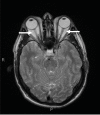The influence of hepatitis C infection and interferon-alpha therapy on thyrotropin blocking and stimulating autoantibodies in Graves' ophthalmopathy: a case report
- PMID: 19954547
- PMCID: PMC2791747
- DOI: 10.1186/1756-6614-2-12
The influence of hepatitis C infection and interferon-alpha therapy on thyrotropin blocking and stimulating autoantibodies in Graves' ophthalmopathy: a case report
Abstract
Background: Hepatitis C virus is a highly immunogenic pathogen often inducing autoimmune activation changes and this can often be further exacerbated by Interferon therapy. As HCV is lymphocytotropic, it can modulate T cell and B cell antibody responses, affecting many endocrine organs, most commonly the thyroid.
Case presentation: We hereby describe a case of fluctuating and wavering thyrotropin autoantibodies of both stimulating and blocking nature in the setting of Graves's ophthalmopathy, hepatitis C infection and interferon-alpha, causing hypo- and subsequently hyper-thyroidism. The autoantibody profile was clearly modified during interferon therapy and settled into a new equilibrium at the completion of treatment.
Conclusion: The case highlights the possible existence of a dual thyroid autoantibody population associated with hepatitis C, and its modulation by interferon therapy, which further compounds the difficulties in the assessment thyroid disease in this setting.
Figures


Similar articles
-
Correlation of orbital muscle changes evaluated by magnetic resonance imaging and thyroid-stimulating antibody in patients with Graves' ophthalmopathy.Acta Endocrinol (Copenh). 1993 Sep;129(3):213-9. doi: 10.1530/acta.0.1290213. Acta Endocrinol (Copenh). 1993. PMID: 8105634
-
Identification of subgroups of euthyroid graves's ophthalmopathy.N Engl J Med. 1977 Jan 27;296(4):181-6. doi: 10.1056/NEJM197701272960401. N Engl J Med. 1977. PMID: 576175
-
Prevalence and significance of thyroid autoantibodies in patients with chronic hepatitis C virus infection: a prospective controlled study.Clin Endocrinol (Oxf). 1999 Apr;50(4):503-9. doi: 10.1046/j.1365-2265.1999.00686.x. Clin Endocrinol (Oxf). 1999. PMID: 10468911
-
B-cell depletion with rituximab in the treatment of autoimmune diseases. Graves' ophthalmopathy the latest addition to an expanding family.Expert Opin Biol Ther. 2007 Jul;7(7):1061-78. doi: 10.1517/14712598.7.7.1061. Expert Opin Biol Ther. 2007. PMID: 17665994 Review.
-
Chemokine (C-X-C motif) ligand (CXCL)10 in autoimmune diseases.Autoimmun Rev. 2014 Mar;13(3):272-80. doi: 10.1016/j.autrev.2013.10.010. Epub 2013 Nov 2. Autoimmun Rev. 2014. PMID: 24189283 Review.
Cited by
-
Hepatitis C virus infection and autoimmune diseases.Int J Gen Med. 2012;5:903-7. doi: 10.2147/IJGM.S37580. Epub 2012 Oct 23. Int J Gen Med. 2012. PMID: 23118549 Free PMC article.
-
Graves' disease following hypothyroidism due to Hashimoto's thyroiditis in a black South African lady: a case report.Pan Afr Med J. 2019 Apr 17;32:186. doi: 10.11604/pamj.2019.32.186.18713. eCollection 2019. Pan Afr Med J. 2019. PMID: 31312298 Free PMC article.
References
-
- Bartalena L, Baldeschi L, Dickinson AJ, Eckstein A, Kendall-Taylor P, Marcocci C, Mourits MP, Perros P, Boboridis K, Boschi A, Currò N, Daumerie C, Kahaly CJ, Krassas G, Lane CM, Lazarus JH, Marinò M, Nardi M, Neoh C, Orgiazzi J, Pearce S, Pinchera A, Pitz S, Salvi M, Sivelli P, Stahl M, von Arx G, Wiersinga WM. Consensus statement of the European Group on Graves' Orbitopathy (EUGOGO) on management of GO. Eur J Endocrinol. 2008;158:273–285. doi: 10.1530/EJE-07-0666. - DOI - PubMed
LinkOut - more resources
Full Text Sources
Research Materials

